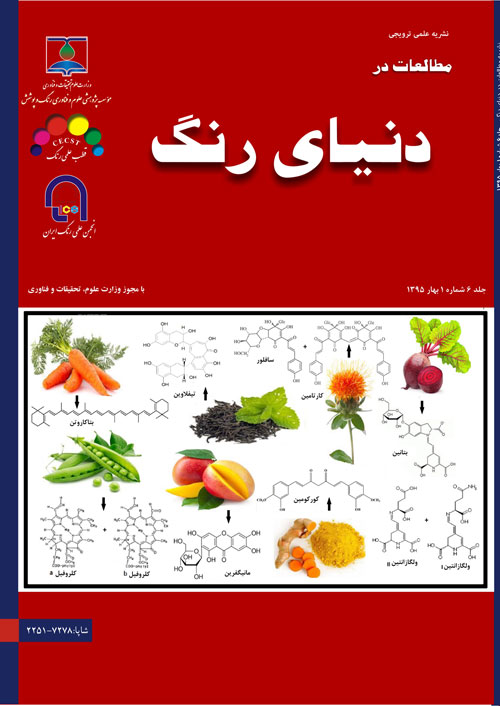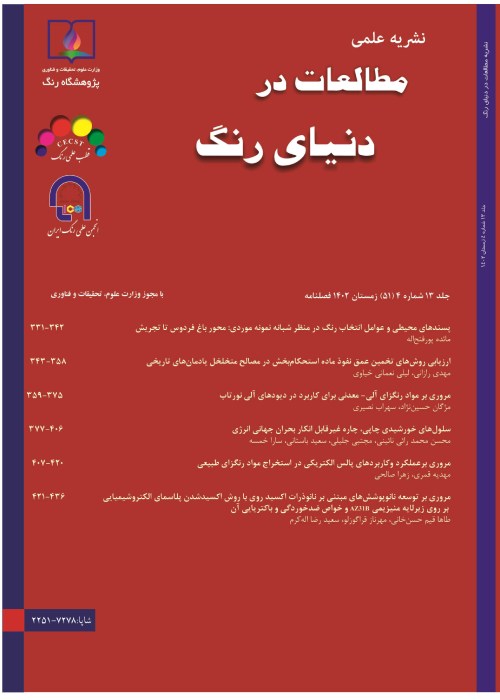فهرست مطالب

نشریه مطالعات در دنیای رنگ
سال ششم شماره 1 (پیاپی 20، بهار 1395)
- تاریخ انتشار: 1395/03/31
- تعداد عناوین: 6
-
-
صفحه 3سلول های خورشیدی پلیمری معمولا از فیلم های نازک فعال نوری بین دو الکترود تشکیل می شوند. روش های متعددی برای تولید لایه های مختلف در سلول های خورشیدی مورد استفاده قرار می گیرند در این بین استفاده از روش های چاپی و پوششی با توجه به سرعت و اقتصادی بودن بسیار مورد توجه قرار گرفته اند. امروزه روش های پوشانش چرخشی، دکتر بلید و پخش کردن برای تولید لایه های فعال نوری در حجم بالا استفاده می شود. اما روش های چاپی دیگری مانند گراور، چاپ جوهرافشان، چاپ به روش پد و چاپ اسکرین و پوشش های دو لایه نیز منجر به تشکیل فیلم های مطلوب برای کاربرد در سلول خورشیدی پلیمری می شود. در این مقاله تمامی روش های چاپی و پوششی مربوط به تولید لایه فعال سلول های خورشیدی پلیمری با تمرکز بر مواد، فناوری های در دسترس و مزایا و معایب هر کدام مورد بررسی قرار می گیرد.کلیدواژگان: سلول خورشیدی پلیمری، پوشش، چاپ، خواص فوتوولتائیک
-
صفحه 13امولسیون های آکریلیک پایه آبی در بسیاری از پوشش های ساختمانی، ترافیکی و چسب ها مورداستفاده قرار می گیرند. از جمله عوامل استفاده گسترده از آنها کاهش چشم گیر آلایندگی محیطی به دلیل داشتن میزان مواد فرار آلی بسیار کم و قیمت پایین آنهاست. فیلم حاصل از امولسیون های آکریلیک، مقاومت بالا در برابر شرایط جوی، مقاومت در برابر پرتو فرابنفش و براقیت بالایی از خود نشان می دهد اما این پوشش ها دارای نواقصی نیز هستند از این رو روش های مختلفی مانند استفاده از نانو مواد و مخلوط کردن آنها با سایر مواد ازجمله پلی یورتان، ترکیبات آلی فلوئوره و سیلیکون های آلی برای بهبود کارآیی رزین های آکریلیک به کار گرفته شده است که با توجه به نوع نیروهای بین پلی اکریلات و ماده ثانویه، روش اصلاح می تواند به دو صورت فیزیکی و شیمیایی انجام شود. در این پژوهش روش های مختلف اصلاح خواص پلی آکریلات ها مورد مطالعه قرارگرفته است.کلیدواژگان: امولسیون های آکریلیک، پوشش های پایه آبی، نانوکامپوزیت های آکریلیک، اصلاح پلی آکریلات، رزین آکریلیک
-
صفحه 23امروزه با توجه به کاهش منابع انرژی و ضرورت صرفه جویی در مصرف آن، استفاده از انواع پوشش های عایق حرارتی در ساختمان سازی و صنایع مختلف مورد توجه قرار گرفته است. پوشش های عایق حرارتی پلیمری، یک دسته از پوشش های عایق هستند که به دلیل استفاده از تقویت کننده های مناسب در بستر پلیمری می توانند دارای خواصی مانند رسانایی گرمایی پائین، مقاومت حرارتی بالا و ضریب جذب پایینی باشند. بهره برداری و اجرای آسان پوشش های عایق پلیمری از دیگر مزایای این پوشش ها می باشند که توجه به این پوشش ها را افزایش داده است. درصورتی که یکی از اجزای اضافه شده در این پوشش ها در مقیاس نانو باشد، پوشش های عایق حرارتی نانوکامپوزیتی تهیه خواهد شد. در این مقاله ابتدا به اختصار به پوشش های نانوکامپوزیتی با ضریب حرارتی کم اشاره خواهد شد و سپس به مدل های ریاضی حاکم بر قوانین انتقال حرارت در این پوشش ها پرداخته خواهد شد.کلیدواژگان: پوشش، نانوکامپوزیت، پلیمر، هدایت حرارتی، محافظ حرارتی
-
صفحه 39سلول های خورشیدی همواره به عنوان یکی از منابع پاک و ارزان قیمت انرژی الکتریکی مورد توجه پژوهشگران قرار گرفته است. این سلول ها، معمولا بر بستری غیر انعطاف پذیرو شکننده از جنس شیشه ساخته می شوند و کارآیی چندانی از این لحاظ نخواهند داشت. به همین دلیل طراحی و ساخت سلول های خورشیدی انعطاف پذیرکه بر بسترهایی منعطف ساخته می شوند. از توجه خاصی نزد محققین برخوردار می باشد. سلول های خورشیدی لیفی شکل یکی از انواع سلول های خورشیدی انعطاف پذیراست که بر بسترهای انعطاف پذیراستوانه ای شکل از جنس سیم های فلزی یا الیاف پلیمری ساخته می شوند. این سلول ها به سه گروه: 1. سلول های لیفی شکل حساس شده به مواد رنگ زا 2. سلول های لیفی شکل پلیمری 3. سلول های لیفی شکل پروسکایتی تقسیم می شوند. این مقاله به بررسی و مرور اجمالی انواع سلول های خورشیدی لیفی شکل، ساختار، عملکرد، محدودیت ها و چالش های موجود در این حوزه، پرداخته است.کلیدواژگان: سلول خورشیدی انعطاف پذیر_ سلول خورشیدی لیفی شکل، الیاف فتوولتائیک، پوشش دهی
-
صفحه 49استفاده از حکاکی اسیدی برای ایجاد نقوش مختلف روی شیشه و تزیین آن در صنعت متداول است. اسید فلوریدریک مایع، املاح و خمیر آن به عنوان عامل خورنده قوی سطح شیشه مورد استفاده قرار می گیرند. در فرآینده حکاکی اسیدی تر از لایه پوششی محافظ (ماسک) برای جلوگیری از گسترش مایع اسید به نواحی غیر حکاکی اسیدی، استفاده می شود. در این بررسی، ابتدا، حکاکی اسیدی و تجهیزات و مراحل فرآیند معرفی می شوند. در ادامه، به اهداف و کاربردهای عمده ی آن و به بررسی خواص مورد نیاز در پوشش محافظ مربوطه پرداخته می شود. این خواص شامل، چسبندگی در فصل مشترک، مقاومت به اسید یا خمیر مورد استفاده، قابلیت اعمال با روش های مختلف، یکنواختی در ضخامت، قابلیت حذف با حلال مناسب، می شوند. در پایان پوشش های متداول حکاکی اسیدی شیشه معرفی می شوند.کلیدواژگان: حکاکی اسیدی شیشه، اسید فلوریدریک، ماسک، عامل خورنده، حلال ها
-
صفحه 63رنگ دانه ها در حقیقت ترکیبات شیمیایی هستند که نور خورشید را در گستره طول موج مرئی جذب می نمایند. در گیاهان چهار گروه اصلی رنگ دانه شامل کلروفیل ها، کاروتنوئیدها، فلاونویدها، و آنتوسیانین ها وجود دارند و دارای خصوصیات و زیرمجموعه های متفاوتی می باشند. کلروفیل ها و کاروتنوئیدها رنگ دانه های نامحلول در آب بوده و در اندامک های سلول ها یافت می شوند، اما فلاونوید ها رنگ دانه های محلول در آب می باشند و در واکوئل ها و سیتوزول وجود دارند. روش های مختلفی برای استخراج رنگ دانه ها، ترکیبات فعال بیولوژیکی و یا دیگر ساختارهای شیمیایی از گیاهان توسعه داده شده اند. این روش های جدید شامل استخراج به کمک امواج فراصوت، استخراج به کمک امواج مایکرو، استخراج توسط سیال فوق بحرانی، و استخراج تسریع شده با حلال می باشند و به کاهش مصرف حلال، افزایش بازده استخراج، و بالا بردن کیفیت عصاره کمک شایانی نموده اند.کلیدواژگان: رنگ دانه، کلروفیل، کارتنوئید، فلاونوید، آنتوسیانین
-
Page 3Polymer solar cells commonly are made of optically active thin film between two electrodes. Film forming technique such as spin coating, doctor blading and casting are used currently for high volume optically active layers production. From a processing point of view, other film-forming techniques such as gravure coating, off-set coating, spray coating and printing technique such as inkjet printing, pad printing and screen printing are favorable to the formation of thin film for polymer solar cells. In this paper, entire process leading to polymer solar cells are investigated with focus on the materials, available techniques and particular advantages and disadvantages associated with each caseKeywords: Polymer solar cell, Coating, Printing, Photovoltaic properties
-
Page 13Water-born acrylic emulsions are used in many applications such as Building paints, traffic coatings and adhesives. The reason of increasing the widespread use of them includes reducing in environmental pollutions because of the low amount of organic volatile compounds (voc) and its low prices. Acrylic emulsion film shows good resistance against environmental conditions, ultraviolet radiation and possess high gloss surface, nevertheless acrylic emulsion coatings have some disadvantages which modified by some methods for improving the performance of acrylic resin including use of Nano materials, mixing with polyurethane, fluorinated compounds and inorganic silicones and Modification method depending on the forces between poly (acrylate) and secondary matter, it can be done chemical or physical. This article reviews several modification methods for poly (acrylate) s.Keywords: Acrylic emulsions, Water, born coating, Poly(acrylate) nanocomposite, Poly(acrylate) modification, Acrylic resin
-
Page 23Due to the reduction of energy resources and the need for savings in consumption, thermal barrier coatings in construction and various industries have been considered. Polymeric thermal barrier coatings are a branch of insulation coatings which for use of suitable reinforcement in the polymeric matrix can contain properties such as low thermal conductivity, high thermal resistance and are low absorption coefficient. Operation and easy application of polymeric insulation coatings are other benefits that have increased the interest to these coatings. If one of the components in this composition was in nano scale, nanocomposite thermal insulation coatings will be prepared. In this article, we will briefly mention nanocomposite coatings for low thermal conductivity and heat transfer rules govern mathematical models of these coatings will be discussed.Keywords: Coatings, Nanocomposites, Polymer, Thermal conductivity, Thermal protection
-
Page 39Solar cells always are considered as clean and low-cost resources of electrical energy by researchers. Typical solar cells are fabricated on inflexible and fragile of glass substrates. Theses solar cells have not performance in aspect of flexibility. So, design and fabrication of solar cells that are fabricated on flexible substrate are very important for researchers. Fiber-shaped solar cell is one of the flexible solar cells that is fabricated on flexible substrates such as metallic wires and polymeric fibers. These solar cells are divided to three groups: 1. Dye sensitized fiber-shaped solar cells 2. Polymeric fiber-shaped solar cells 3. Perovskite fiber-shaped solar cells. This paper briefly reviewed fiber-shaped solar cells, structure, performance, limitations and challenges in this field.Keywords: Flexible solar cell, Fiber, shaped Solar cell, Photovoltaic Fibers, Coating
-
Page 49Surface etching technique is commonly used for industrial decoration of glasses. Hydrofluoric acid (HF) solutions or pastes, pure or mixed with other chemicals, are employed as strong corrosive agents to engrave chemically the glass surface. In the wet etching method protective layers as masks are required extensively to prevent the flow of corrosive liquids to undesired regions. Here, in this study, the corrosive etching technique on different surfaces, and the corresponding processes with their required tools are introduced. In continuation, the mask property requirements are discussed. They include topics such as; interfacial adhesion, and chemical resistances properties to acid and corrosive paste, relevant glass masking techniques, uniformity of the mask film and mask removal or the dissolution by appropriate solvents. Lastly, conventional protective coatings in wet etching of glass are introduced.Keywords: Glass etching, Hydrofluoric acid, Mask, Corrosive agent, Solvents
-
Page 63Pigments are chemical compounds that absorb light in the wavelength range of the visible region. There are four main classified groups of plants pigment including Chlorophyll, Carotenoids, Flavonoids, and Anthocyanin which have different characteristics. Chlorophyll and Carotenoids are insoluble in water and are found in organelles of cells, while the Flavonoids are water-soluble pigments present in vacuole and cytosol. Various novel techniques including ultrasound-assisted extraction, microwave-assisted extraction, supercritical fluid extraction, and accelerated solvent extraction have been developed for the extraction of nutraceuticals from plants in order to shorten the extraction time, decrease the solvent consumption, increase the extraction yield, and enhance the quality of extracts.Keywords: Pigment, Chlorophyll, Carotenoid, Flavonoid, Anthocyanin


